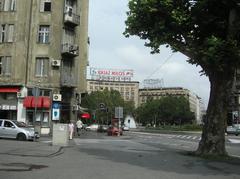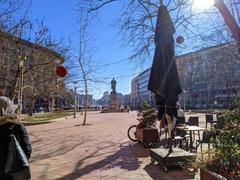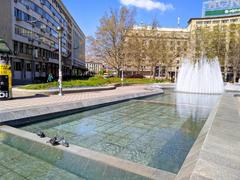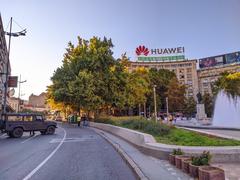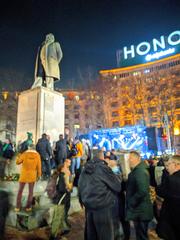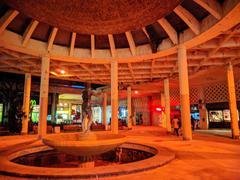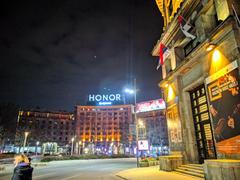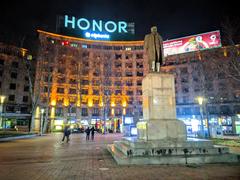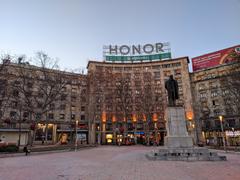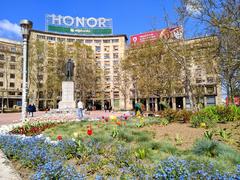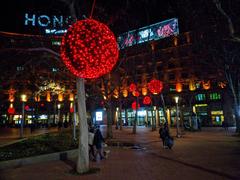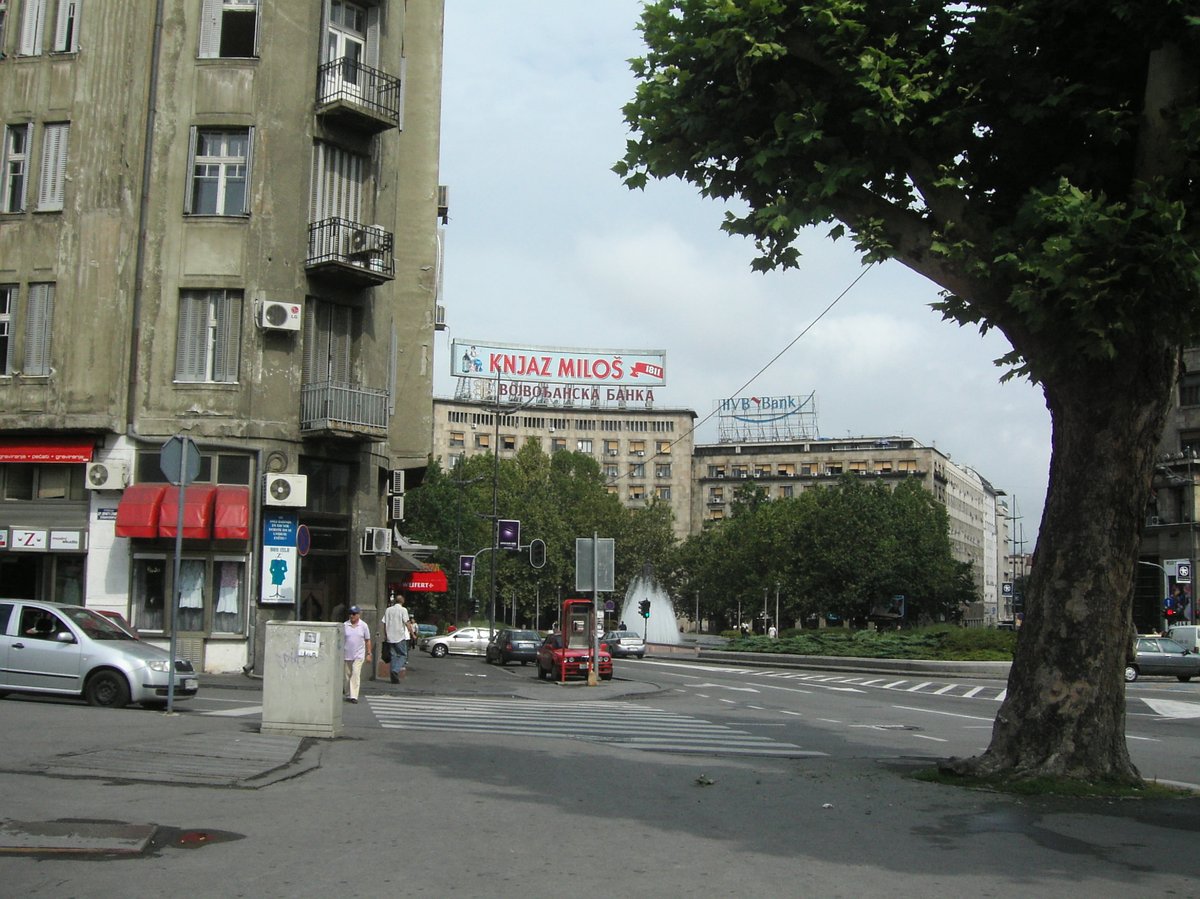
Nikola Pašić Square Belgrade: Visiting Hours, Tickets, and Historical Sites Guide
Date: 14/06/2025
Introduction
Nikola Pašić Square (Trg Nikole Pašića) is one of Belgrade’s most significant urban spaces, embodying the city’s rich historical layers and dynamic public life. Strategically located in the heart of Serbia’s capital, the square stands as a testament to Belgrade’s post-World War II transformation and ongoing evolution. Named after Nikola Pašić, a key Serbian and Yugoslav statesman, the square balances monumental architecture, vivid cultural activity, and political symbolism. Visitors are treated to a compelling mix of historical landmarks, public art, and contemporary events, making it an essential stop for anyone exploring Belgrade.
This comprehensive guide offers detailed information on Nikola Pašić Square’s history, architecture, visiting hours, accessibility, ticketing, nearby attractions, and practical travel advice. Whether you’re a history buff, architecture enthusiast, or casual traveler, this guide will help you get the most out of your visit.
For further details and resources, consult Spomenik Database, Eyes on Belgrade, and Belgrade Spots.
Historical Overview
Origins and Early Development
Nikola Pašić Square emerged during Belgrade’s significant post-WWII urban renewal, replacing a patchwork of streets and buildings. Originally known as Marx and Engels Square, it was conceived as a symbolic center for socialist rallies and public events, reflecting the prevailing ideology of the then-Yugoslav government (Spomenik Database). The late 1940s and early 1950s saw the square’s transformation into a cohesive public space, marking a major shift in Belgrade’s cityscape.
Architectural Evolution
The square’s design was shaped by architects like Hranislav Stojanović and emphasized open pedestrian areas, monumental architecture, and public art. The Dom Sindikata (House of the Syndicates), completed in 1957, became a defining feature—serving as a cultural and social venue and a prominent example of socialist realism and late modernism (Eyes on Belgrade). The Bezistan, a passage inspired by Ottoman markets, and the central fountain further define the square’s character (Belgrade Spots).
Transformation and Modernization
In the 1980s, the square underwent pedestrianization and greening, with the planting of plane trees and the reconstruction of its central fountain. Today, the fountain—surrounded by hexagonal tiles—remains a focal point, and the area is known for its accessibility and active urban life (Spomenik Database; Eyes on Belgrade).
Political and Cultural Significance
The square has long been a venue for political gatherings and cultural events. With the dissolution of Yugoslavia, it was renamed after Nikola Pašić in the 1990s, and a statue of Pašić was installed in 1998 (Belgrade Spots). The square is surrounded by critical landmarks, including the National Assembly of Serbia, the Old Palace (City Hall), and the Historical Museum of Serbia, reinforcing its role as a site of national memory and public life (Eyes on Belgrade).
Contemporary Developments
Recent years have brought commercial elements like illuminated billboards atop Dom Sindikata and public debates over renovations, particularly concerning the fountain. These discussions highlight the square’s importance as a cultural and civic icon (Spomenik Database).
Visiting Nikola Pašić Square
Visiting Hours
Nikola Pašić Square is an open public space, accessible 24 hours a day, every day of the year. Surrounding institutions such as the National Assembly and museums have their own opening hours.
Tickets and Admission
There is no entrance fee for the square itself. Tickets are only required for nearby attractions like the Historical Museum of Serbia (400 RSD for adults) or for events at Dom Sindikata (IMUS Visitor Information).
Accessibility
The square is fully pedestrian-friendly, equipped with ramps and smooth pathways for wheelchairs and strollers. Public transport options are abundant, with multiple bus, tram, and trolley lines stopping nearby (IMUS Visitor Information).
Amenities
- Seating and Greenery: Benches and shaded areas throughout the square.
- Cafés and Restaurants: Numerous options nearby for refreshments.
- Shops and ATMs: Convenience stores and banking services are easily found in the vicinity.
- Restrooms: Available in adjacent cafés and shopping centers.
Getting There
By Foot
The square is within walking distance from central neighborhoods such as Stari Grad and Terazije. Signage from major city arteries leads directly to the square (Evendo).
By Public Transport
- Buses: Lines 16, 23, 31, 37, 58, 76, 83, 84, 95
- Trolleys: Lines 19, 21, 22, 29, 40, 41
- Trams: Lines 2, 5, 6, 7, 12
- Mini-bus: Line E6
Tickets can be purchased at kiosks or via the BusPlus system (IMUS Visitor Information).
By Taxi or Ride-Sharing
Taxis and ride-sharing services like CarGo are widely available. Simply enter “Nikola Pašić Square” as your destination.
By Car (Parking)
Nearby public garages:
- Pionirski Park Garage: Dragoslava Jovanovića 2 (Parking Servis)
- Politika Garage: Makedonska 29 (Parking Servis)
Architectural and Cultural Highlights
Dom Sindikata
A monumental example of socialist realism, this building was constructed between 1947 and 1957. Declared a cultural monument in 2013, it remains a hub for concerts, films, and events (Wikipedia).
The Fountain
Central to the square, the large fountain—remodeled in 1987—serves as a gathering spot and visual anchor. Its preservation is a point of local pride and heritage (Wikipedia).
Monument to Nikola Pašić
Installed in 1998, the bronze monument commemorates the statesman for whom the square is named. It stands as a popular photo spot and meeting place (Belgrade Spots).
Surrounding Landmarks
- National Assembly of Serbia: A Beaux-Arts architectural gem and political centerpiece (Never Ending Footsteps).
- Stari Dvor (Old Palace) and Novi Dvor (New Palace): Former royal residences, now governmental offices.
- Historical Museum of Serbia: Offers exhibitions on Serbian history (IMUS Visitor Information).
- Pionirski Park: Provides green space and recreation adjacent to the square.
Experiences and Activities
Events and Public Life
Nikola Pašić Square hosts open-air concerts, art exhibitions, political rallies, and seasonal markets. During holidays, the square transforms with festive decorations and live performances (Evendo).
Walking and Guided Tours
The square is a key stop on many Belgrade walking tours, including historical, architectural, and communist-era themed routes (Project Expedition).
Food and Nightlife
Surrounding the square are traditional Serbian kafanas, modern eateries, and wine bars offering local specialties. Dom Sindikata regularly hosts concerts and film festivals (Belgrade Beat Guide).
Family-Friendly and Rainy Day Options
Nearby parks, playgrounds, and interactive museums make the area family-friendly. On rainy days, enjoy films at Dom Sindikata or explore local cafés (Belgrade Beat Guide).
Practical Visitor Tips
- Best Time to Visit: Spring and autumn for mild weather; evenings for illuminated architecture; weekends for markets and events.
- Safety: Well-lit and generally safe with a visible police presence.
- Currency: Serbian dinar (RSD) is used; ATMs and card payments are widely available.
- Language: Serbian is official, but English is commonly spoken in tourist areas.
- Wi-Fi: Many cafés offer free Wi-Fi; public connections may vary in quality.
- Local Etiquette: Greet with “Dobar dan” (Good day) and thank with “Hvala.” Tipping ~10% is appreciated.
- Emergency: Dial 112 for police, fire, or ambulance.
Frequently Asked Questions (FAQ)
Q: What are the visiting hours of Nikola Pašić Square?
A: The square is open 24/7.
Q: Is there an entrance fee?
A: No, the square is free to visit. Tickets are required only for specific museums or events.
Q: Is Nikola Pašić Square accessible?
A: Yes, the square is wheelchair accessible.
Q: Are guided tours available?
A: Yes, many city tours include the square; museums offer group visits by appointment.
Q: Where can I park?
A: Use nearby public garages such as Pionirski Park or Politika.
Q: What are the best photo spots?
A: The Nikola Pašić statue, the fountain, and the illuminated National Assembly at night.
Interactive Map and Visuals
Explore Nikola Pašić Square and nearby attractions on Google Maps.
[Insert high-quality images with descriptive alt text, such as: “Monument to Nikola Pašić at sunset,” “Dom Sindikata’s façade,” “Central fountain with surrounding greenery.“]
Summary and Recommendations
Nikola Pašić Square is central to Belgrade’s urban and cultural life. Its blend of historical significance, monumental architecture, and vibrant events offers an immersive experience for every visitor. With 24/7 accessibility, proximity to major attractions, and excellent public transport links, the square serves as both a destination and a gateway to further exploration in Belgrade.
For the latest updates, download the Audiala app and follow official tourism channels. Enjoy your visit, and embrace Nikola Pašić Square as a living crossroads of Belgrade’s history and modern city spirit.
Sources and Further Reading
- This guide references:
